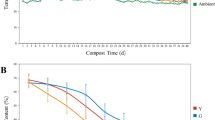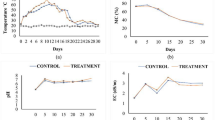Abstract
Rice straw (RS) is an important raw material for the preparation of Agaricus bisporus compost in China. In this study, the characterization of composting process from RS and wheat straw (WS) was compared for mushroom production. The results showed that the temperature in RS compost increased rapidly compared with WS compost, and the carbon (C)/nitrogen (N) ratio decreased quickly. The microbial changes during the Phase I and Phase II composting process were monitored using denaturing gradient gel electrophoresis (DGGE) and phospholipid fatty acid (PLFA) analysis. Bacteria were the dominant species during the process of composting and the bacterial community structure dramatically changed during heap composting according to the DGGE results. The bacterial community diversity of RS compost was abundant compared with WS compost at stages 4–5, but no distinct difference was observed after the controlled tunnel Phase II process. The total amount of PLFAs of RS compost, as an indicator of microbial biomass, was higher than that of WS. Clustering by DGGE and principal component analysis of the PLFA compositions revealed that there were differences in both the microbial population and community structure between RS- and WS-based composts. Our data indicated that composting of RS resulted in improved degradation and assimilation of breakdown products by A. bisporus, and suggested that the RS compost was effective for sustaining A. bisporus mushroom growth as well as conventional WS compost.








Similar content being viewed by others
References
Bååth E (2003) The use of neutral lipid fatty acids to indicate the physiological conditions of soil fungi. Microb Ecol 45:373–383
Bremner JM, Mulvaney C (1982) Nitrogen-total 1. In: Page AL (ed) Methods of soil analysis. Part 2. Chemical and microbiological properties. American Society for Agronomy, Medison, pp 595–624
Córdova-Kreylos AL, Cao Y, Green PG, Hwang H-M, Kuivila KM, LaMontagne MG, Van De Werfhorst LC, Holden PA, Scow KM (2006) Diversity, composition, and geographical distribution of microbial communities in california salt marsh sediments. Appl Environ Microbiol 72:3357–3366
Cahyani VR, Matsuya K, Asakawa S, Kimura M (2003) Succession and phylogenetic composition of bacterial communities responsible for the composting process of rice straw estimated by PCR-DGGE analysis. Soil Sci Plant Nutr 49:619–630
Carpenter-Boggs L, Kennedy AC, Reganold JP (1998) Use of phospholipid fatty acids and carbon source utilization patterns to track microbial community succession in developing compost. Appl Environ Microbiol 64:4062–4064
De Groot PWJ, Basten D, Sonnenberg ASM, Van Griensven L, Visser J, Schaap PJ (1998) An endo-1,4-beta-xylanase-encoding gene from Agaricus bisporus is regulated by compost-specific factors. J Mol Biol 277:273–284
Dees PM, Ghiorse WC (2001) Microbial diversity in hot synthetic compost as revealed by PCR-amplified rRNA sequences from cultivated isolates and extracted DNA. FEMS Microbiol Ecol 35:207–216
Dungait JAJ, Kemmitt SJ, Michallon L, Guo S, Wen Q, Brookes PC, Evershed RP (2011) Variable responses of the soil microbial biomass to trace concentrations of 13C-labelled glucose, using 13C-PLFA analysis. Eur J Soil Sci 62:117–126
Eichner CA, Erb RW, Timmis KN, Wagner-Döbler I (1999) Thermal gradient gel electrophoresis analysis of bioprotection from pollutant shocks in the activated sludge microbial community. Appl Environ Microbiol 65:102–109
Eiland F, Klamer M, Lind AM, Leth M, Baath E (2001) Influence of initial c/n ratio on chemical and microbial composition during long term composting of straw. Microbiol Ecol 41:272–280
Fan F (2007) Method of detecting water-soluble carbon in organic fertilizer. China Meas Technol 33:63–64 (in Chinese)
Foulongne-Oriol M, Spataro C, Savoie J-M (2009) Novel microsatellite markers suitable for genetic studies in the white button mushroom Agaricus bisporus. Appl Microbiol Biotechnol 84:1125–1135
Frostegård A, Bååth E (1996) The use of phospholipid fatty acid analysis to estimate bacterial and fungal biomass in soil. Biol Fertil Soils 22:59–65
Hedrick DB, Peacock A, White DC (2005) Monitoring and assessing soil bioremediation. Interpretation of fatty acid profiles of soil microorganisms. Springer, Berlin, pp 251–259
Ishii K, Fukui M, Takii S (2000) Microbial succession during a composting process as evaluated by denaturing gradient gel electrophoresis analysis. J Appl Microbiol 89:768–777
Jpg G (1988) Nutrition and compost. In: van Griensven LJLD (ed) The cultivation of mushrooms. Darlington Mushroom Laboratories, Rustington, pp 29–72
Kato K, Miura N, Tabuchi H, Nioh I (2005) Evaluation of maturity of poultry manure compost by phospholipid fatty acids analysis. Biol Fertil Soils 41:399–410
Klamer M, Bååth E (1998) Microbial community dynamics during composting of straw material studied using phospholipid fatty acid analysis. FEMS Microbiol Ecol 27:9–20
LaMontagne MG, Michel FC Jr, Holden PA, Reddy CA (2002) Evaluation of extraction and purification methods for obtaining PCR-amplifiable DNA from compost for microbial community analysis. J Microbiol Methods 49:255–264
Liu D, Zhang R, Wu H, Xu D, Tang Z, Yu G, Xua Z, Shen Q (2011) Changes in biochemical and microbiological parameters during the period of rapid composting of dairy manure with rice chaff. Bioresour Technol 102:9040–9049
Macdonald LM, Paterson E, Dawson LA, McDonald AJS (2004) Short-term effects of defoliation on the soil microbial community associated with two contrasting Lolium perenne cultivars. Soil Biol Biochem 36:489–498
Mengel K, Kirkby EA, Kosegarten H, Appel T (2001) Further elements of importance. In: Mengel K, Kirkby EA, Kosegarten H, Appel T (eds) Principles of plant nutrition. Springer, Dordrecht, pp 639–655
Muyzer G, De Waal EC, Uitterlinden AG (1993) Profiling of complex microbial populations by denaturing gradient gel electrophoresis analysis of polymerase chain reaction-amplified genes coding for 16S rRNA. Appl Environ Microbiol 59:695–700
Nübel U, Garcia-Pichel F, Kühl M, Muyzer G (1999) Quantifying microbial diversity: morphotypes, 16s rRNA genes, and carotenoids of oxygenic phototrophs in microbial mats. Appl Environ Microbiol 65:422–430
Noble R, Gaze R (1994) Controlled environment composting for mushroom cultivation: substrates based on wheat and barley straw and deep litter poultry manure. J Agric Sci 123:71–79
Noble R, Hobbs JP, Mead A, Dobrovin-Pennington A (2002) Influence of straw types and nitrogen sources on mushroom composting emissions and compost productivity. J Ind Microbiol Biotechnol 29:99–110
Peters S, Koschinsky S, Schwieger F, Tebbe CC (2000) Succession of microbial communities during hot composting as detected by PCR-single-strand-conformation polymorphism-based genetic profiles of small-subunit rRNA genes. Appl Environ Microbiol 66:930–936
Rashad FM, Saleh WD, Moselhy MA (2010) Bioconversion of rice straw and certain agro-industrial wastes to amendments for organic farming systems: 1. Composting, quality, stability and maturity indices. Bioresour Technol 101:5952–5960
Ross RC, Harris PJ (1982) Some factors involved in phase II of mushroom compost preparation. Sci Hortic 19:223–229
Royse DJ (1985) Effect of spawn run time and substrate nutrition on yield and size of the shiitake mushroom. Mycologia 77:756–762
Scrase R (1996) Cultivating mushrooms: making composted and non-composted substrates. Mycologist 10:52–55
Sekiguchi H, Watanabe M, Nakahara T, Xu B, Uchiyama H (2002) Succession of bacterial community structure along the Changjiang river determined by denaturing gradient gel electrophoresis and clone library analysis. Appl Environ Microbiol 68:5142–5150
Sharma S, Rangger A, Insam H (1998) Effects of decomposing maize litter on community level physiological profiles of soil bacteria. Microbiol Ecol 35:301–310
Simsek H, Baysal E, Colak M, Toker H, Yilmaz F (2008) Yield response of mushroom (Agaricus bisporus) on wheat straw and waste tea leaves based composts using supplements of some locally available peats and their mixture with some secondary casing materials. Afr J Biotechnol 7:88–94
T-t Song, W-m Cai, Q-l Jin, W-l Feng, L-j Fan, Y-y Shen, Fang H, F-f Tian (2014) Comparison of microbial communities and histological changes in phase I rice straw-based Agaricus bisporus compost prepared using two composting methods. Sci Hortic 174:96–104
Straatsma G, Gerrits JPG, Thissen JTNM, Amsing JGM, Loeffen H, Van Griensven LJLD (2000) Adjustment of the composting process for mushroom cultivation based on initial substrate composition. Bioresour Technol 72:67–74
Szekely AJ, Sipos R, Berta B, Vajna B, Hajdu C, Marialigeti K (2009) DGGE and T-RFLP analysis of bacterial succession during mushroom compost production and sequence-aided T-RFLP profile of mature compost. Microb Ecol 57:522–533
Tiquia SM, Wan H, Tam NF (2002) Microbial population dynamics and enzyme activities during composting. Compost Sci Util 10:150–161
Vargas-García M, Suárez-Estrella F, López M, Moreno J (2010) Microbial population dynamics and enzyme activities in composting processes with different starting materials. Waste Manag 30:771–778
Wang CM, Shyu CL, Ho SP, Chiou SH (2007) Species diversity and substrate utilization patterns of thermophilic bacterial communities in hot aerobic poultry and cattle manure composts. Microb Ecol 54:1–9
Yu M, Zeng G, Chen Y, Yu H, Huang D, Tang L (2009) Influence of Phanerochaete chrysosporium on microbial communities and lignocellulose degradation during solid-state fermentation of rice straw. Process Biochem 44:17–22
Yu Z, Morrison M (2004) Comparisons of different hypervariable regions of rrs genes for use in fingerprinting of microbial communities by PCR-denaturing gradient gel electrophoresis. Appl Environ Microbiol 70:4800–4806
Zelles L (1999) Fatty acid patterns of phospholipids and lipopolysaccharides in the characterisation of microbial communities in soil: a review. Biol Fertil Soils 29:111–129
Acknowledgments
This work was financially supported by the Jiangsu Agricultural Science and Technology Independent Innovation Fund Project CX(13)5072.
Author information
Authors and Affiliations
Corresponding author
Rights and permissions
About this article
Cite this article
Wang, L., Mao, J., Zhao, H. et al. Comparison of characterization and microbial communities in rice straw- and wheat straw-based compost for Agaricus bisporus production. J Ind Microbiol Biotechnol 43, 1249–1260 (2016). https://doi.org/10.1007/s10295-016-1799-6
Received:
Accepted:
Published:
Issue Date:
DOI: https://doi.org/10.1007/s10295-016-1799-6




